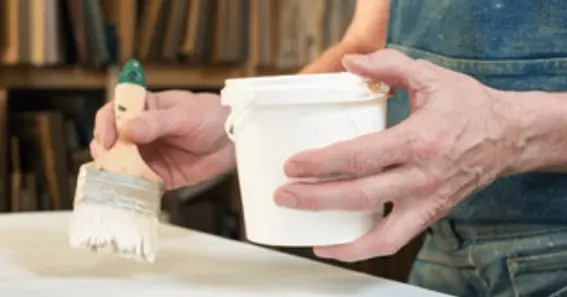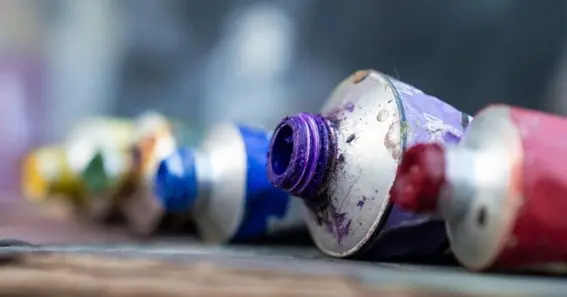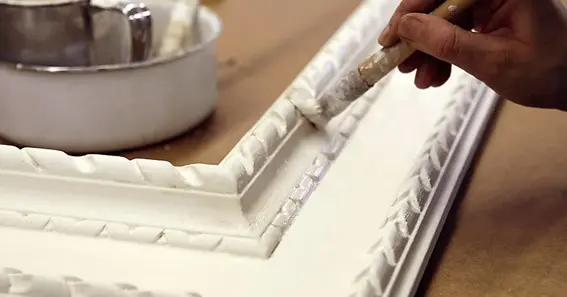What is gesso? Gesso is a white primer used to prepare surfaces like canvas or wood for painting by creating a smooth, absorbent base. For years, artists have utilized gesso, a white fluid layer. As a basis, gesso prepares walls for painting or drawing. Art will live longer because of this. Try gesso to paint on something other than fabric, wood, plaster, or air-drying clay. Artists benefit from its rougher surface. It also improves paint adhesion. In this article we discuss about what is gesso and more about it.
What Is Gesso?
Gesso is a white primer used to prepare surfaces like canvas or wood for painting by creating a smooth, absorbent base. Paste, chalk, gypsum, color, and a glue-like ingredient made gesso. Priming surfaces, especially for oil paintings, with this traditional formula helped the paint cling and not seep through. Modern gesso is more flexible and workable due to acrylic resins. Gesso is usually a thick, white liquid that dries flat and slightly abrasive. This finish facilitates paint adhesion. Keeping colors vivid and accurate to the artist’s intent prevents the paint from getting below.
Essential Gesso Knowledge

Know what is gesso before learning how to apply it. Consider gesso more than a base coat. This crucial phase can make or destroy your painting. Everything is here, from how to use gesso to the numerous types and how to apply it.
Different Uses
If you know what is gesso, you should know gesso requires a lot of practice to master. Apply gesso with brushes, rollers, or palette knives. The tool you use depends on the color. You are spreading gesso across the surface with a broad, flat brush that yields the smoothest finish. For larger areas, use a brush to smooth the coat. If you want a more fascinating surface, apply gesso in thicker, more dramatic lines with a palette knife.
Use thin, equal layers of gesso and let each dry before applying more. Layers strengthen your art. Some projects need two or three applications of gesso, depending on the surface and desired feel. Working with raw fabric or wood may require more layers to create a basis that doesn’t soak up too much.
Drying Time
The coating thickness and weather determine drying time. Gesso dries to the touch in 20–30 minutes. Allow it to cure for a few hours before drawing on it. Before adding another layer, let the first dry. Rushing through this phase may cause cracks or weird textures. Your art may appear different.
Artists in muggy conditions may need to prepare ahead because it takes longer to cool. Even if you want to speed up drying, don’t use heat. This may bubble or fracture gesso. Work slowly with gesso since a nice surface may make or break your project.
Paint Between Coats
Artists should sand between gesso treatments for a smooth surface. After each layer dries, use fine-grit sandpaper to fix faults. This phase helps with realistic, detailed painting that needs a good base. It removes brushstrokes and rough places from sanding. Smooth surfaces are ideal for drawing little objects.
However, you can omit this step to make your style more expressive and meaningful. The rough surface of the gesso can make your painting enjoyable and better. You decide whether to sand between layers since you control the outcome.
Different Gesso Types

Getsso has numerous varieties, each valid for different tasks. Sometimes dubbed “true gesso,” some painters still use it in classic painting forms. Natural ingredients include rabbit skin glue. This gesso stiffens and absorbs, so oil painters use it to prepare wood frames.
Acrylic primer is used for oil and acrylic painting. Nowadays, most people have that type. It dries rapidly and has various uses. Acrylic gesso bends and won’t break on diverse surfaces. Different hues of Gesso exist. White gesso is most prevalent; however, black and colorful gesso are available.
Application Of Gesso To Surfaces
Gesso can be used for more than simply painting because it can be used on many surfaces. Panel painting often uses wood. Sealing wood with gesso prevents breakage and warping. Gesso creates a solid, paint-resistant surface. This prolongs art.
To stabilize plaster and stone for murals and other art, prime them with gesso. Gesso stiffens and strengthens cardboard and paper, making them ideal for drawing. For painting on odd or fragile surfaces, this is quite helpful. Before painting, gesso can aid in molding and making self-drying clay. This improves paint adhesion and durability.
Gesso And Mixed Media
If you read what is gesso, you should know gesso is crucial in mixed media. Mixed media art combines many techniques and materials. Because it makes a rough surface, painters can stack objects to create more intricate pieces. Use gesso to prepare collage surfaces. This sticks the paper together and prevents curling and peeling.
You can tint gesso with acrylic paint to match a mixed-media creation. This expands creativity. Artists who want to experiment with shapes and materials will love Gesso. It can unite mixed media pieces.
Conclusion
Artists use gesso because it supports numerous sorts of art. Its flexibility, smoothness, and ease of use make it a crucial artist tool. Using gesso properly will elevate your art, whether you paint, carve, or mixed media. You can make your art appear fantastic and last with the appropriate information. In above we discuss about what is gesso and explore more about it.
FAQ
Why Gesso Your Paintings?
The gesso base makes the surface gritty. This improves paint adhesion and prevents soaking.
Can I Paint Without Priming On Raw Paper?
Paint on raw cotton without gesso may not lay flat. The surface would dull and absorb more.
Use How Many Gesso Layers?
For most applications, two to three gesso coats are plenty. Rough or water-absorbing surfaces may need more.
Can I Paint On Gesso?
Gesso works on stone, paper, cardboard, wood, plaster, and spontaneously drying clay. That makes it an excellent foundation for many things.
Do You Need A Base Coat Before You Use Paints To Paint?
Gesso isn’t required for acrylic painting, but it helps the paint stick, enhances the colors, and prolongs the art.
Sources:










